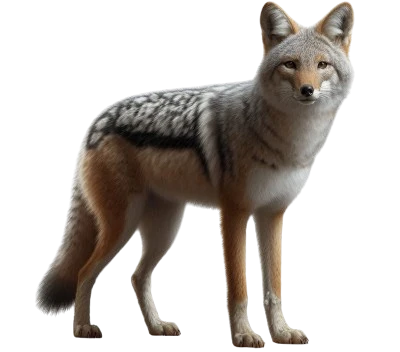
The Central Asia Jackal (Canis aureus) is a medium-sized, highly adaptable and opportunistic predator, primarily living in the arid and semi-arid regions of Central Asia. Although it is often confused with other species of jackals, it has distinct characteristics that allow it to survive in harsh environments.
The Central Asia Jackal is a medium-sized canid, measuring between 50 and 60 cm at the shoulder and weighing between 8 and 12 kg. Its coat is usually grayish to golden, with lighter shades on the belly. It has a slender build and a long bushy tail. Its ears are large and pointed, and its yellow eyes give it a lively and alert expression.
The Central Asia Jackal belongs to the Canidae family, like wolves and coyotes.
The Central Asia Jackal is one of the most flexible and adaptable members of the Canis genus, capable of surviving in a variety of habitats while remaining an opportunistic predator.
The Central Asia Jackal primarily inhabits the steppes, deserts, and semi-arid regions of Central Asia, ranging from Kazakhstan to India and Pakistan. It prefers areas with sparse vegetation but can also be found in agricultural zones and near human villages, where it can easily find food.
The Central Asia Jackal is generally solitary or lives in small family groups. It is mostly active at twilight and dawn, hunting alone or in small groups. This canid is an opportunistic feeder, eating small mammals, birds, reptiles, and also fruits and insects. It is also known for scavenging through human trash for food.
The Central Asia Jackal is an opportunistic carnivore, primarily hunting small animals such as rodents, birds, and lizards. It also consumes fruits and berries, especially during food shortages. It is not hesitant to scavenge from carcasses and may also prey on small live animals like rabbits or gazelles.
The Central Asia Jackal is currently considered a species of low risk due to its high adaptability and wide distribution. However, it is sometimes threatened by habitat loss, hunting, and competition with domestic dogs. Protecting its natural habitats and managing conflicts with humans are crucial to ensuring its long-term survival.
The Central Asian Jackal belongs to the genus Canis, which also includes the Gray Wolf (Canis lupus), the Coyote (Canis latrans), and the Golden Jackal (Canis aureus). These species share common characteristics, such as their complex social structure and adaptability to various environments.
Observing the Central Asia Jackal in its natural habitat can be a rewarding experience. Here are some tips for observing these animals while respecting their environment:
By following these recommendations, you will be able to observe the Central Asia Jackal while contributing to its conservation.